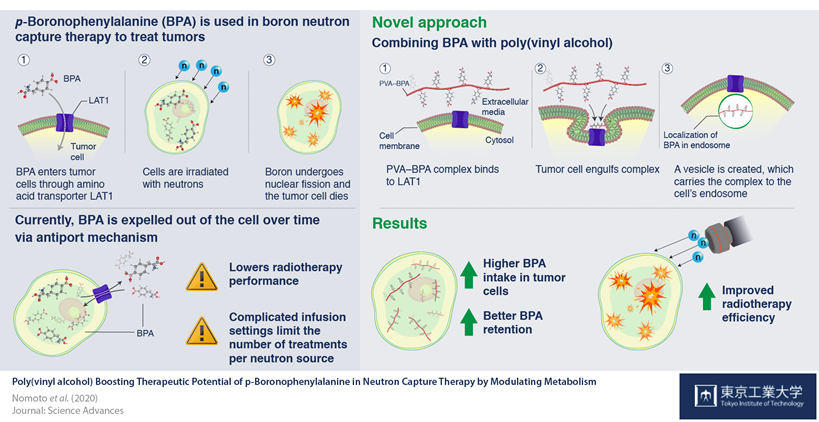News Releases & Research Results How to keep boron inside cells during radiotherapy: a simple novel approach to cancer treatment
News Releases & Research Results
Tokyo Institute of Technology
Kyoto University
Innovation Center of NanoMedicine
STELLA PHARMA CORPORATION
Japan Agency for Medical Research and Development
Boron neutron capture therapy (BNCT) is a technique in which p-boronophenylalanine (BPA) is transferred to cancer cells, and the boron in it undergoes nuclear fission reaction upon irradiation of thermal neutrons, releasing high energy particles that kill the cells. However, current technology allows only a short timeframe of BPA in the cell. Scientists at Tokyo Institute of Technology (Tokyo Tech), Kyoto University, and Innovation Center of NanoMedicine (iCONM) improved upon current BNCT by combining BPA with poly(vinyl alcohol) to produce the PVA-BPA complex, which has a longer cell retention time, enhancing the cancer-killing potential of BNCT.
The growing knowledge about cancer biology has enhanced the development of many therapeutic strategies that involve selective targeting and killing of cancer cells. One such therapeutic option is boron neutron capture therapy (BNCT), a radiotherapy process involving transferring boron into cancer cells, and exposing it to neutron particles, causing it to undergo nuclear fission, which kills the cancer cells. If we can ensure that boron is present only in cancer cells, we can specifically destroy only cancer cells, without harming the normal cells of the body.
Scientists first discovered the way to induce this “selective uptake” using p-boronophenylalanine (BPA). BPA is a boron-containing compound with a phenylalanine structure. One of the factors that distinguishes cancer cells from normal cells is an overabundance of special structures called “LAT1 amino acid transporters”, which recognize and allow the transport of phenylalanine into the cell. So, when BPA is present outside cancer cells, these transporters on the cell-surface allow it to enter cancer cells, permitting successful BNCT. BPA has long been considered the best drug available for BNCT.
However, BPA has a drawback; once BPA levels increase within the cancer cells, it is expelled back out via an “antiport” mechanism, making it challenging for BNCT to be effective in some cases. Thus, patients are required to receive a continuous infusion of BPA for 30–60 minutes, to maintain the necessary amount in the cells for the reaction to be successful. This also leaves the door open for human errors, such as the possibility of dislodging the needle during the process.
To overcome these drawbacks, scientists at Tokyo Tech, Kyoto University and iCONM led by Prof. Nobuhiro Nishiyama decided to explore other means of retaining boron inside cancer cells for longer periods. “We assumed,” Prof. Nishiyama states, “that modulating the presence of BPA inside the cell will ensure that they are not sent back out via their antiport mechanism.”
To examine this, they mixed a compound called poly(vinyl alcohol) (PVA) and BPA together, to form a PVA-BPA complex, and observed the internalization of this compound in cancer cells. They found that the addition of PVA did not affect the phenylalanine structure of BPA, allowing the LAT1 transporters to recognize the PVA-BPA complex. However, as this complex was too large to pass through the transporters, the LAT1 transporters instead engulfed the complex in organelles called endosomes and transported them into the cells. Since BPA was now safely located in endosomes, the cancer cell was not able to push it out immediately by the antiport mechanism. This ensured that boron remains in cells for a long enough time for the cancer cells to be effectively killed. This method was also tested in animal models, and anti-cancer activities of BNCT were found to be enhanced.
Addition of PVA thus presents an extremely simple solution to boost the therapeutic potential of BPA. “This technique is effortless,” notes Prof. Nishiyama, “and offers a novel approach for drug delivery, focusing on the metabolic elimination processes of drugs. We will advance research on the PVA-BPA complex for clinical trials in cooperation with STELLA PHARMA CORPORATION who has conducted BPA clinical trials.”

Reference
- Authors:
- Takahiro Nomoto1*, Yukiya Inoue1, Ying Yao1, Minoru Suzuki2, Kaito Kanamori1, Hiroyasu Takemoto1, Makoto Matsui1, Keishiro Tomoda1, Nobuhiro Nishiyama1,3*
- Title of original paper:
- Poly(vinyl alcohol) Boosting Therapeutic Potential of p-Boronophenylalanine in Neutron Capture Therapy by Modulating Metabolism
- Journal:
- Science Advances
- DOI:
- 10.1126/sciadv.aaz1722
- Affiliations:
-
- Laboratory for Chemistry and Life Science, Institute of Innovative Research, Tokyo Institute of Technology, Kanagawa
- Division of Particle Radiation Oncology, Particle Radiation Oncology Research Center, Institute for Integrated Radiation and Nuclear Science, Kyoto University, Osaka
- Innovation Center of Nanomedicine (iCONM), Kawasaki Institute of Industrial Promotion, Kanagawa
- *Corresponding author’s email:
- nomoto"AT"res.titech.ac.jp and nishiyama.n.ad"AT"m.titech.ac.jp
(Replace"AT"with @.)
About Tokyo Institute of Technology
Tokyo Institute of Technology stands at the forefront of research and higher education as the leading university for science and technology in Japan. Tokyo Tech researchers excel in a variety of fields, such as material science, biology, computer science and physics. Founded in 1881, Tokyo Tech has grown to host 10,000 undergraduate and graduate students who become principled leaders of their fields and some of the most sought-after scientists and engineers at top companies. Embodying the Japanese philosophy of “monotsukuri,” meaning technical ingenuity and innovation, the Tokyo Tech community strives to make significant contributions to society through high-impact research.
Website: https://www.titech.ac.jp/english/
About Kyoto University
Kyoto University is one of Japan and Asia's premier research institutions, founded in 1897 and responsible for producing numerous Nobel laureates and winners of other prestigious international prizes. A broad curriculum across the arts and sciences at both undergraduate and graduate levels is complemented by numerous research centers, as well as facilities and offices around Japan and the world. For more information, please see: http://www.kyoto-u.ac.jp/en
About Innovation Center of NanoMedicine (iCONM)
Innovation Center of NanoMedicine (iCONM) is a leading facility building an innovation hub for life science at King SkyFront in Kawasaki. iCONM started the operation in April 2015 with Kawasaki Institute of Industry Promotion as the business entity. Researchers from various universities and companies in Japan and overseas aiming to realize a smart life care society gathered together in the open innovation environment for efficient collaboration by academia, industry and government for creating very unique ideas.
Website: https://iconm.kawasaki-net.ne.jp/
About STELLA PHARMA CORPORATION
Stella Pharma is committed to implementing its corporate mission to “shed new light on medical practice worldwide to save every irreplaceable life” as a principle of our corporate philosophy. To realize this corporate philosophy, we have been working to deliver BNCT to the market as a new treatment for incurable cancer since the founding of the corporation. For more information, please refer to the website: https://stella-pharma.co.jp/
About The Japan Agency for Medical Research and Development (AMED)
AMED was established in 2015 for the advancement of medical discoveries that make life better for everyone. AMED’s mission is to fast-track medical R&D with an alliance and cooperativity of the ministries (CAO, METI, MEXT and MHLW). AMED provides seamless support on medical research, from basic research to clinical applications, by centralizing grants in the field of medicine. Based on effective partnerships and innovative collaboration, AMED pursues medical breakthroughs through an approach consisting of three vital components; Funding for medical studies and research facilities, Linking organizations, institutions and researchers, and Promotion for the practical application of beneficial research outcomes.
Website: https://www.amed.go.jp/en/index.html
Contact
Kazuhide Hasegawa
Public Relations Section, Tokyo Institute of Technology
E-mail.media"AT"jim.titech.ac.jp
+81-3-5734-2975
The Japan Agency for Medical Research and Development (AMED):
Division of Cancer Research, Department of Research Promotion
Email:cancer"AT"amed.go.jp
*Replace"AT"with @.
Links
01/23/20
Last updated 01/23/20

